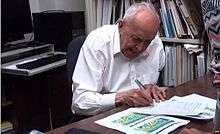Franz Halberg
| Franz Halberg | |
|---|---|
 | |
| Born |
July 5, 1919 Romania |
| Died |
June 9, 2013 (aged 93) Minneapolis, Minnesota, U.S. |
| Education | M.D. |
| Occupation | Professor |
| Employer | University of Minnesota |
| Known for | Chronobiology |
| Website | Halberg Chronobiology Center, |
Franz Halberg (July 5, 1919 – June 9, 2013[1] ) was a scientist and one of the founders of modern chronobiology. He first began his experiments in the 1940s and later founded the Chronobiology Laboratories at the University of Minnesota. Halberg published many papers also in the serials of the History Commission of International Association of Geomagnetism and Aeronomy (IAGA), edited by Wilfried Schröder. He also published in "Wege zur Wissenschaft, Pathways to Science", edited by Wilfried Schröder his biography. He was a member of many international bodies, he had five titles as Dr. honoris causa, and was a member of the Leibniz Sozietät der Wissenschaften zu Berlin. In the 1950s, he introduced the word circadian, which derives from the Latin about (circa) a day (diem).[2]

Franz Halberg was nominated several times for the Nobel Prize in Physiology or Medicine. In 1988, and again in 1989, upon invitation by Professor Björn Nordenström of the Karolinska Institute in Sweden, then a member of the Nobel committee, Germaine Cornelissen, close associate of Franz, nominated Franz for the prize, highlighting the different ingredients contributed by Franz in developing the discipline of chronobiology. Professor Björn Nordenström had come to the University of Minnesota to give a major lecture and accepted Franz's invitation to come and visit his laboratory. The invitation was extended upon Björn's return to Sweden, at the Minneapolis airport where Franz and Germaine had accompanied him to continue discussions of work of mutual interest. After Nordenström left the committee, Franz's dossier assembled by Germaine was handed over to Dr. Dora K. Hayes of the U.S. Department of Agriculture, who had a colleague eligible to make nominations.[3]
References
- ↑ "Dr. Franz HALBERG Obituary". Pioneer Press. June 16, 2013. Retrieved 13 August 2013.
- ↑ Halberg, Franz; et al. (2003-10-29). "Transdisciplinary unifying implications of circadian findings in the 1950s". Journal of Circadian Rhythms. 1 (2). doi:10.1186/1740-3391-1-2. PMC 317388
 . PMID 14728726. Retrieved 2013-11-29.
. PMID 14728726. Retrieved 2013-11-29. Eventually I reverted, for the same reason, to "circadian" ...
- ↑ Fernholm B., Bremer K., Jörnvall H. (eds.). The Hierarchy of Life: Molecules and Morphology in Phylogenetic Analysis. Proc. Nobel Symposium 70, Alfred Nobel's Björkborn, Karlskoga, Sweden, August 29-September 2, 1988. International Congress Series, Nr. 824. Excerpta Medica, Amsterdam, 1989, 499 pp.